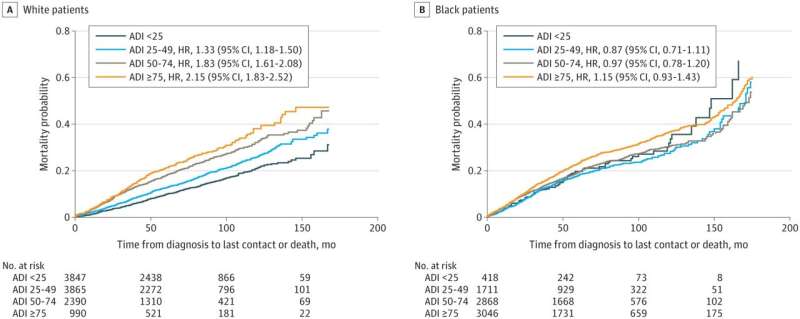Breast cancer mortality reflected differently in certain Georgia neighborhoods, study reveals

New research from University of Alabama at Birmingham researchers is shedding light on racial disparities in breast cancer mortality in women who live in economically deprived neighborhoods.
The findings, published in JAMA Network Open, suggest that neighborhood deprivation has a differential impact on breast cancer mortality in Black and white women. In a cohort of 19,850 breast cancer patients living in Georgia, the researchers found that while white women who lived in economically less deprived neighborhoods showed decreased mortality, Black women showed high mortality regardless of their neighborhood's economic condition.
Ritu Aneja, Ph.D., professor and associate dean for Research and Innovation in the UAB School of Health Professions, served as lead author on the study. Aneja's research laboratory focuses on understanding why breast cancer outcomes (both survival rates and treatment outcomes) differ between white and Black women in the United States.
"It is common knowledge that the quality of one's neighborhood impacts health," Aneja said. "Logic would seem to dictate that moving from a poor neighborhood to an affluent one should translate into improved health outcomes. But in Atlanta, we found that this was not true across races. We found that white women with breast cancer who lived in less deprived neighborhoods indeed had lower mortality than white women living in highly disadvantaged neighborhoods. However, this was not the case for Black women with breast cancer."
Aneja's team found that irrespective of the type of neighborhood they lived in, Black women had poor health outcomes and mortality rates relative to white women; even more surprisingly, the outcomes were no better for Black women in affluent neighborhoods than for Black women in more deprived areas. "Essentially, moving from more deprived to less deprived areas (low to high economic bracket overall) results in health gains for one racial community but not the other," she said.
The data were collected from three major health care systems in Georgia between 2004 and 2020. Each patient was assigned an area deprivation index (ADI) score based on their residential census block group. The ADI of each neighborhood is calculated using 17 different indicators, including income, education, employment, and housing quality. Aneja and her colleagues found that Black women are disproportionately more likely to live in high-deprivation areas, and higher deprivation is associated with unfavorable breast cancer outcomes.
Although Black women in the United States have a lower incidence of breast cancer than white women, the overall age-adjusted breast-cancer mortality is about 40% higher among Black women than among white women (27.7 vs. 20.0 deaths per 100,000 women from 2014 through 2018). Aneja says that several states exceed the national statistics, many of which are in the South—Georgia, North Carolina, South Carolina, Tennessee, West Virginia and Arkansas—and the three states with the highest racial disparities in breast cancer outcomes are in the South—Louisiana, Mississippi and the District of Columbia.
Aneja says there is an urgent need for national-level studies of racial breast cancer disparities in relation to area of residence or neighborhood deprivation. Aneja calls for other, similar studies to explore the biological and epigenomic linkages between racism, discrimination and poor health outcomes in other types of cancer as well.
More information: Justin M. Luningham et al, Association of Race and Area Deprivation With Breast Cancer Survival Among Black and White Women in the State of Georgia, JAMA Network Open (2022). DOI: 10.1001/jamanetworkopen.2022.38183





















